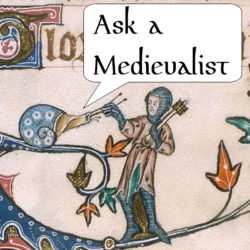Synopsis
Let’s talk about possible pagan origins for everyone’s favorite late-December excuse to eat a lot of pie. In addition, Em and Jesse discuss the surprisingly capitalist early traditions associated with St. Nicholas and the various strange beings who accompany Santa in different countries, from Pere Fouettard (who whips bad children in France) to the Krampus.
Annotations and Corrections
1/ At the time we recorded this episode, it sounded as though the Big 10 were not going to have a season, but the Big 10 later announced an eight-game season (by the time this comes out, the Badgers will have played six with two cancellations because of the plague). The Wisconsin state legislature is still extremely useless.
Gimme that Old Time Religion as performed by the inimitable Pete Seeger.
Sadly, this wound up being the twenty-third episode posted. But it was the twenty-fifth one recorded.
Jesse: Here’s an article in the Chicago Tribune and a picture of the Atheist/Agnostic “A” (with a sigh wishing everyone “Happy Winter Solstice”) in Daley Plaza. (I guess it went up in 2013 for the first time.) https://www.chicagotribune.com/news/ct-xpm-2013-12-04-chi-atheists-agnostics-have-their-own-display-at-daley-plaza-20131204-story.html Here’s a picture of the “A” lit up at night. https://wgnradio.com/wgn-radio/a-christmas-tree-a-menorah-and-a-giant-a/ The Christmas tree moved to Millenium Park in 2015, Leaving the Menorah, Nativity scene, and “A” in Daley Plaza. I have seen the Kinara there as well for Kawanza, but for some reason I can’t find pictures of it on the interwebs.
2/ The Feast of the Circumcision: in Jewish tradition, baby boys are circumcised eight days after birth in a ceremony called a bris (in Yiddish) or brit milah (Hebrew). So counting the 25th as day 1, Jesus’ bris was on Jan 1st. If you want to know just waaay too much about ritual circumcision, here is that wikipedia page, and if you want to live a happy life don’t ever get involved in a discussion of circumcision on the internet.
3/ Jesse mentions that St. Nicholas’s day is Dec 6th. This year, for the first time ever, I saw a sign in our supermarket saying, “Don’t forget St. Nicholas’s Day!” (I guess reminding people to buy gifts or something for their kids?) [Oh, wow! I’ve definitely heard the occasional reference from people I know who celebrate it, but I’ve never seen a USA business reference it.–Jesse]
4/ The comic about the Xmas tree, and here’s one about Mithras, too. (You can click on the panels to view them at a larger size.)
Jesse: When I say the importance of the SUN to Christianity I do not mean the son/sun pun (which doesn’t work in Latin); I mean the metaphor of God as the Sun (frequently portrayed as beams of light in medieval paintings).
5/ [26:10] The cattle of the sun are from The Odyssey.
Jesse: In The Odyssey the cattle of the sun belong to Helios (a Titan), but in the Homeric “Hymn to Hermes,” the baby Hermes steals the cattle of the sun (brilliantly) from Apollo (the Olympian sun god). This is why it’s so hard to be definitive about anything. Here’s the “Hymn to Hermes:” https://www.perseus.tufts.edu/hopper/text?doc=Perseus%3Atext%3A1999.01.0138%3Ahymn%3D4
Apis bull: https://en.wikipedia.org/wiki/Apis_(deity)
You can read the bull of heaven story here starting at p. 14. The main moral is, as a corollary to “When someone asks you if you’re a god, you say YES,” consider the rule, “If a goddess asks you out, try to let her down gently.” Basically, when Ishtar/Inanna proposes to Gilgamesh, he says, “Hey…haven’t you had a bunch of lovers that you got tired of and left?” and then he lists them off. Ishtar/Inanna is…not charmed by this behavior, as you might expect.
6/ We discussed the Christ child and the women who associated themselves with Mary and so on in episode 6 (Mysticism and Motherhood).
7/ Jesse: For more on the African wise man, see The Image of the Black in Western Art Vol 2: From the Early Christian Era to the “Age of Discovery” Pt 1: From the Demonic Threat to the Incarnation of Sainthood pp 21-25. African men first appear in imagery as attendants: an attendant of Herod, in a scene of the Magi before Herod painted near Rouen in the late 1100s, and as attendants of the Magi by the 1260s (for example, Nicola Pisano’s pulpit in Siena https://www.gettyimages.com/detail/news-photo/italy-tuscany-region-siena-baptistry-nicola-pisano-pulpit-news-photo/122216191). By the second half of the 1300s, the image of an African magus/king seems to have appeared, and it’s well established by the 1400s. https://www.amazon.com/Image-Black-Western-Art-Incarnation/dp/0674052560
Em: [36:40] I feel like St. Francis trying to make this point about how you don’t really need a church (building), etc. is an interesting lesson in how some people wind up as heretics and some don’t. Because let’s be clear–there were definitely monks who got declared heretics because they claimed that Christ and his disciples owned no property and therefore they (the monks) should be allowed to not own any property singly or jointly. [Yeah, it helps to have a pope on your side! Pope Gregory IX, to be exact (starting when he was a cardinal)–see Episode 4 nt 15.–Jesse]
Jesse: For more on Francis as Mary Magdalene, see episode 11 (in the vicinity of note 35). Here we’re discussing Francis imitating the Virgin Mary (for more on this see Catherine M. Mooney, “Imitiatio Christi or Imitatio Mariae?: Clare of Assisi and Her Interpreters,” in Gendered Voices: Medieval Saints and Their Interpreters, ed. Catherine M. Mooney (Philadelphia: University of Pennsylvania Press, 1999), 52-77).
The First and Second Lives of St. Francis were written by Thomas of Celano, while Bonaventure’s (slightly later) Life of Francis became the official version. I’m quoting my own translations of the Latin here.
8/ The Slaughter (or Massacre) of the Innocents was the subject of many important and affecting paintings, including by Guido Reni and Peter Paul Reubens. I cannot think what it must be like acted out. (Also, Caravaggio did a lot of great paintings with religious themes, but as far as I can tell he didn’t do one of the slaughter of innocents. Oops.)
9/ Caganer https://en.wikipedia.org/wiki/Caganer See also the poop log Tió de Nadal or Caga tió: https://en.wikipedia.org/wiki/Tió_de_Nadal
Apologies that this is coming out too late for you all to order one for your nativity scenes this year.
10/ Père Fouettard. I (Em) am just now realizing as I write this out that “fouette” is the French word for whipping (i.e., crème fouetté = whipped cream), so Père Fouettard is like Father Whips-a-Lot. There’s your etymology lesson for the day.
11/ Myroblyte saints: https://en.wikipedia.org/wiki/Myroblyte_saint
Jesse: The symbolism that has arisen around the gifts assumes that the gold=king; frankincense=God (incense is burned during mass, for example); myrrh=mortal/death (it foretells Christ’s death as the unction that would be used for Last Rites). Of course Christ was Jewish, and Jews didn’t perform Last Rites. Nonetheless, all the gifts are symbolic of kingship.
I think this is what Jesse means by the traditional pawn broker’s insignia: https://upload.wikimedia.org/wikipedia/commons/5/5c/Pawnbroker%27s_sign%2C_Camden_High_Street%2C_London.JPG [Yes!!–Jesse]
This is the Medici coat of arms. More variations here.
12/ Black Pete / Zwarte Piet. For reference, the Reconquista started in the 700s and ended in 1492. [The Reconquista refers to Christian attmepts to take back the Iberian penensul from Muslim rule after the Umayyad conquest. It took a while..–Jesse]
13/ Krampus.
14/ Jean Bodel (c.1165-c.1210), author of Le Jeu de saint Nicholas, the first non-liturgical play written in French. Bodel later died of leprosy. [Everyone should check out the chapter on him in Carol Symes A Common Stage https://www.amazon.com/Common-Stage-Medieval-Conjunctions-Religion/dp/0801445817 –Jesse]
If somehow you haven’t seen one, this is a bishop’s mitre.
Jesse: The King from Beyond the Withered Tree has a name that’s supposed to suggest that he’s from waaaaaaaaaaaaaaaaay out in the nowhere lands. However, the Middle Ages also had a legend about an ancient tree (possibly near Hebron) that dried up when Christ died. (Since early modern times it’s been associated with the Oak of Mamre.) The concept of a “dry tree” marking a significant spot/event is not specific to Christianity. Anyhow, the point is that he’s from beyond the boundaries of…all the known religions? Very far away. For more on the dry tree, see Gasse, Rosanne. “The Dry Tree Legend in Medieval Literature.” Fifteenth-Century Studies 38, edited by Rosanne Gasse and Barbara I. Gusick, by Edelgard E. DuBruck, vol. 38, Boydell & Brewer, Rochester, New York, 2013, pp. 65–96; 91 nt 26.
15/ Prince Albert of Saxe-Coburg-Gotha was Queen Victoria’s cousin by virtue of her mother having been the sister of his father. They had nine children together, all of whom lived to adulthood. Their son became Edward VII, the first monarch of the House of Saxe-Coburg-Gotha. They changed the name to Windsor during WWI because of anti-German sentiment. Also, they were related to basically half of the people who were monarchs in Europe, including the Russian czar and King Leopold I.
16/ Jesse: Here is Christ hanging in the branches of the Tree of Knowledge of Good and Evil as the serpent tempts Adam and Eve, foreshadowing the fact that the Fall of Adam and Eve will give rise to Christ, the new Adam who will open the door (to eternal life/salvation/heaven) that Adam and Eve closed. (Mary is the new Eve, a virgin who not only resists temptation but bears God’s child/fruit.) In essence, Adam and Eve gain Knowledge but lose Eternal Life (they’re banned from the Garden so they won’t eat the fruit of the Tree of Life and gain immortality alongside their knowledge, thus becoming like gods). However, the Cross is the new Tree of Life, and Christ is its fruit. The depiction of the serpent with a woman’s face seducing Eve is a conversation for another time. https://www.getty.edu/art/collection/objects/3672/willem-vrelant-adam-and-eve-eating-the-forbidden-fruit-flemish-early-1460s/
Here is one of many, many images of the cross planted in Adam’s skull: https://commons.wikimedia.org/wiki/File:Francesco_di_Vannuccio._Crucifixion_with_the_Virgin_and_Saint_John_the_Evangelistc._1387-88_Philadelphia_Museum_of_Art_(CAT94).jpg Fra Angelico took a more subtle approach: https://www.metmuseum.org/art/collection/search/437007
Here is the beginning of 8 miniatures in the Hours of Catherine of Cleves on the Legend of the True Cross. (Seth is dispatched for a branch from the Tree of Mercy.) https://www.themorgan.org/collection/hours-of-catherine-of-cleves/191 (The miniature are every few pages, so hit next a few times.) Here is the tress growing from Adam’s skull: https://www.themorgan.org/collection/hours-of-catherine-of-cleves/202
Here’s a random image of Eve on one side of the Tree of Knowledge and Mary and the Christ child on the other. https://www.themorgan.org/collection/hours-of-catherine-of-cleves/222
17/ I cannot find a clip of the scene in The Lion in Winter that I am describing, but you can see the tree in this clip. Also, the clip contains Katherine Hepburn being amazing.
18/ Okay, instead of hiding from your family, people are probably more likely to be spending Christmas mostly alone this year. Hope this episode provides a bit of distraction, if not a salve.
Podcast: Play in new window | Download
Subscribe: Spotify |





